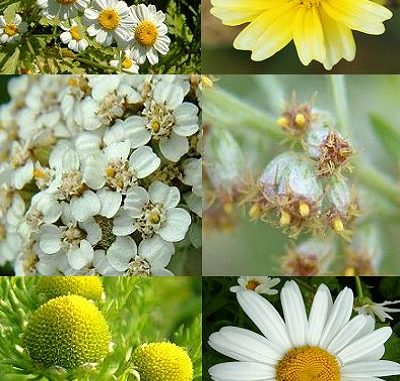
- This family is also known as Daisy family.
- It includes the plants that are normally cultivated for ornamental flowers as well as for oil value.
- They are annual garden herbs.
Roots: They have tap root system and the roots are branched.
Stem:
- The stem is erect, branched and cylindrical.
- It may be herbaceous or woody.
- It is pubescent (covered with soft short hair) and green in color.
Leaves:
- Simple leaves; entire and spathulate
- They are cauline or ramal, alternate or exstipulate.
- The leaves are sessile or petiolate, acute or serrate and with unicostate reticulate venation.
Inflorescence:
- Racemose head or capitulum with three series of involucre of leafy bracts like in sunflower
- Capitulum may be covered by green involucre consisting of single series of bracts.
Flower:
- 2 kinds of florets (central tubular disc florets surrounded by peripheral ray florets) in the large capitulum
- Bracteate, regular, epigynous, sessile
- May be bisexual or unisexual, actinomorphic or zygomorphic
Ray floret:
- Bracteate or ebracteate, sessile
- incomplete, unisexual, pistillate or neuter, ligulate
- zygomorphic and epigynous, yellow to orange in color.
Calyx:
- Sepals are normally absent.
- If present, they are represented by 2 or 3 small scales or hairy pappus, superior
Corolla:
- 3 to 5 teeth are present that represent the number of petals
- Gamopetalous, ligulate with large flat strap-shaped limb and a basal hairy tube
- Valvate, superior and yellow to orange in color
Androecium: Stamens are generally absent.
Gynoecium:
- Bicarpellary syncarpous with inferior ovary
- Ovary is unilocular with only one ovule with basal placentation.
- Style is simple and slender whereas stigma is bifid and curved.
Disc floret:
- Bracteate or ebracteate, sessile, actinomorphic
- My be complete or incomplete, bisexual
- Tubular, epigynous, actinomorphic
- Small and yellow to orange in color
Calyx:
- Absent or reduced and modified into 2 or 3 membranous white scales, superior
Corolla:
- 5 teeth representing the number of petals
- gamopetalous, tubular, valvate, superior
- yellow to orange in color
Andorecium:
- 5 stamens are present, epipetalous, alternating with the petals, superior
- filament is short and free
- anther is large, dithecous with prolonged connective
- syngenesious and introsse
Gynoecium:
- bicarpellary syncarpous
- ovary is inferior and unilocular with large ovule
- basal placentation, style is simple whereas stigma is bifid
Fruit: Cypsela
Floral diagram with floral formula (Helianthus annuus or sunflower):

Some important plants of the family:
- Helianthus annuus (Sunflower)
- Calendula officinalis (Englilsh marigold)
- Tanacetum coccineum (The painted daisy)
- Arctotis fastuosa (Monarch of the veld)
- Townsendia jonesii (Townsend daisy)
- Helianthus tuberosus (Jerusalem artichoke)
- Carthamus tinctorius (safflower)
- Chrysanthemum coccineum (pyrethrum)
Econonmic importance:
- Helianthus annuus (sunflower) seeds yield edible oil.
- Helianthus tuberosus (Jerusalem artichoke) root tubers are edible.
- Carthamus tinctorius (safflower) petals yield an orange dye and the oil is used for the manufacture of soap, dye, varnish and is also edible.
- Artemisia vulgaris (mugwort) and Artemisia maritima (sea wormwood) flowers yield santonine, a drug used for curing intestinal worms, asthma and brain disorders.
- Chrysanthemum coccineum (pyrethrum) roots yield pyrethrum, an insecticide.
- Enhydra fluctuans (water cress) leaves are used as vegetable and also to cure insomnia (sleeplessness).
- Eclipta alba (false daisy) leaves are used as hair tonic.
- Tagetes erecta (Mexican marigold) flowers are used for eye diseases, purification of blood and in ulcers.
- Calendula spp.(marigold), Tagetes patula (the French marigold), Chrysanthemum spp. etc. have ornamental value (used as decorative plants).